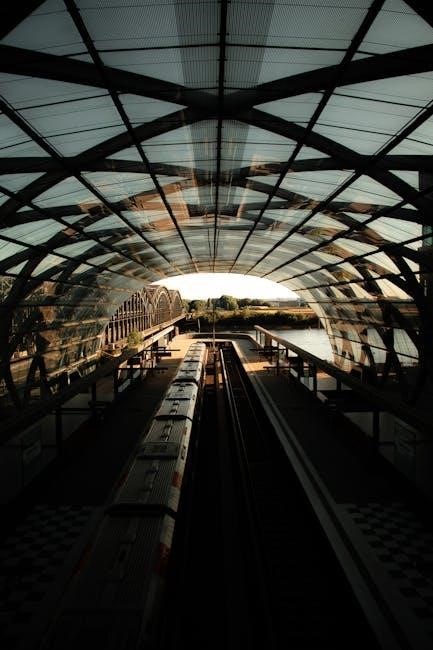Rail guides are essential tools for planning and navigating train journeys‚ offering schedules‚ routes‚ and tips for travelers․ They help simplify rail travel‚ making it more accessible and enjoyable for everyone․

1․1 What Are Rail Guides?
Rail guides are comprehensive resources designed to assist travelers in planning and navigating train journeys․ They provide detailed information about train schedules‚ routes‚ and destinations‚ helping users make informed decisions․ Available in both printed and digital formats‚ rail guides often include maps‚ timetables‚ and tips for maximizing travel efficiency․ These tools cater to both seasoned commuters and first-time travelers‚ offering insights into ticketing options‚ station layouts‚ and scenic routes․ By simplifying the complexities of rail travel‚ rail guides enhance the overall travel experience‚ ensuring passengers can explore destinations with ease and confidence․
1․2 Importance of Rail Guides in Travel Planning
Rail guides play a crucial role in simplifying and enhancing the travel planning process․ They provide essential information such as train schedules‚ routes‚ and destinations‚ enabling travelers to make informed decisions․ By offering insights into ticketing options‚ station layouts‚ and scenic routes‚ rail guides empower travelers to plan their journeys efficiently․ They are particularly valuable for first-time travelers‚ helping to reduce confusion and ensure a smooth experience․ Rail guides also cater to varying preferences‚ offering tips for budgeting‚ selecting accommodations‚ and exploring local cultures․ Their comprehensive nature makes them indispensable for anyone looking to navigate rail networks confidently‚ ensuring that travelers can focus on enjoying their journey rather than getting lost in logistics․

History of Rail Guides
Rail guides originated with printed timetables and maps‚ evolving over time to include detailed travel information․ They transitioned from paper to digital formats‚ enhancing accessibility and user-friendliness․
2․1 Evolution of Rail Travel
Rail travel has undergone significant transformation since its inception in the 19th century․ The introduction of steam locomotives revolutionized land transportation‚ connecting cities and fostering economic growth․ Over time‚ trains evolved from slow‚ cumbersome vehicles to high-speed‚ efficient modes of transport․ The 20th century saw the rise of electrified railways and bullet trains‚ enhancing speed and comfort․ Today‚ modern rail systems integrate advanced technology‚ offering real-time updates and seamless ticketing․ This evolution has made rail travel more accessible‚ convenient‚ and environmentally friendly‚ solidifying its role as a vital part of global transportation networks․
2․2 Development of Rail Guides Over Time
Rail guides have evolved significantly‚ transitioning from printed timetables to comprehensive digital platforms․ Early guides were simple pamphlets with schedules and routes‚ while modern versions offer interactive maps‚ real-time updates‚ and booking capabilities․ The digital revolution transformed rail guides‚ enabling travelers to plan journeys more efficiently․ Innovations like mobile apps and online ticketing systems have further enhanced accessibility․ Today‚ rail guides incorporate AI-driven recommendations‚ personalized itineraries‚ and integrated transportation networks‚ making travel planning seamless and user-friendly․ This evolution reflects advancements in technology and changing traveler preferences‚ ensuring rail guides remain indispensable tools for exploring destinations worldwide․

Types of Rail Guides
Rail guides come in various forms‚ including printed timetables‚ digital apps‚ and online platforms․ Each type offers unique benefits‚ catering to different traveler needs and preferences effectively․
3․1 Printed Rail Guides
Printed rail guides remain a popular choice for travelers‚ offering detailed timetables‚ maps‚ and station information in a tangible format․ They are often preferred for their ease of use and accessibility without the need for digital devices․ These guides typically include comprehensive route details‚ fare information‚ and tips for navigating train networks․ Printed rail guides are particularly useful for planning journeys in advance and for those who prefer a physical copy to refer to during their trip․ They are widely available at train stations‚ tourist information centers‚ and online for pre-travel planning․ Despite the rise of digital tools‚ printed rail guides continue to be a reliable and user-friendly resource for travelers‚ especially in areas with limited internet access․ They also serve as a backup for digital tools‚ ensuring travelers stay informed throughout their journey․
3․2 Digital Rail Guides
Digital rail guides have revolutionized the way travelers plan and manage their rail journeys․ Available as mobile apps and websites‚ they provide real-time updates‚ interactive maps‚ and personalized route recommendations․ These tools allow users to search for destinations‚ book tickets‚ and track train schedules seamlessly․ Features like push notifications for delays and live tracking enhance the travel experience․ Digital rail guides also offer features such as fare comparisons and ticket booking‚ making them a convenient option for modern travelers․ They are accessible anywhere with internet connectivity‚ making them ideal for last-minute changes or unexpected disruptions․ Digital rail guides are constantly updated‚ ensuring users have the most accurate and current information at their fingertips․ This makes them an indispensable resource for both seasoned travelers and first-time rail users alike․
Planning a Rail Journey
Planning a rail journey involves researching destinations‚ budgeting‚ and using routing tools․ Tips for first-time travelers include booking early‚ packing light‚ and staying informed about schedules and delays․
4․1 Tips for First-Time Rail Travelers
First-time rail travelers should arrive early to familiarize themselves with the station layout and ticketing processes․ Always double-check schedules and platform numbers to avoid missed trains․ Packing light is essential‚ as storage space on trains can be limited․ Bring snacks‚ water‚ and entertainment for longer journeys․ Consider booking seats with power outlets and Wi-Fi for comfort․ Research any necessary documents‚ such as rail passes or reservations‚ and ensure they are easily accessible․ Staying informed about delays or route changes through apps or announcements is crucial․ Lastly‚ plan for contingencies like unexpected delays by having a backup itinerary․ These tips ensure a smooth and enjoyable rail travel experience․
4․2 How to Use Routing and Scheduling Tools
Using routing and scheduling tools is crucial for efficient rail travel planning․ Start by entering your origin and destination points to view available routes․ Select your preferred date and time to see matching train schedules․ Use filters to refine results based on preferences like direct routes‚ duration‚ or comfort class․ Many tools allow comparisons of prices and amenities across different train services․ Once satisfied with your selection‚ proceed to book tickets online or through the app․ Regularly check for real-time updates and delays‚ as schedules may change․ Utilize features like route maps to visualize your journey and plan connections․ Advanced tools may offer itinerary suggestions or alternative routes if disruptions occur․ Always save or print your itinerary for easy access during travel․
4․3 Budgeting for Your Rail Trip
Budgeting for a rail trip involves careful planning to manage costs effectively․ Start by researching ticket prices‚ which vary based on class‚ flexibility‚ and demand․ Booking in advance often secures lower fares‚ while last-minute purchases can be expensive; Consider budget-friendly options like economy class or off-peak travel․ Additional expenses include food‚ accommodation‚ and activities at destinations․ Use online tools to compare prices and look for discounts or special offers․ Allocating a portion of your budget for unexpected costs ensures financial flexibility․ Packing snacks and utilizing free amenities can reduce spending․ Budgeting apps or spreadsheets help track expenses‚ ensuring you stay within your means․ Planning ahead and making smart financial decisions allows you to enjoy your rail journey without overspending․
4․4 Selecting the Right Accommodation
Selecting the right accommodation for your rail trip is crucial for a comfortable journey․ Consider hotels or hostels near train stations to minimize travel time․ Budget-friendly options like guesthouses or hostels can save money without sacrificing comfort․ Research amenities such as Wi-Fi‚ luggage storage‚ and meal services․ Read reviews to ensure the accommodation meets your needs․ Booking in advance‚ especially during peak seasons‚ guarantees availability and better rates․ Look for accommodations offering rail travel packages or discounts for train passengers․ Location is key—opt for places near city centers or attractions to maximize your exploration time․ Balancing cost‚ convenience‚ and quality ensures a stress-free and enjoyable rail travel experience․

Infrastructure and Routes
Rail infrastructure varies globally‚ with extensive networks in Europe‚ Asia‚ and North America․ Routes often connect major cities‚ offering scenic views and convenient travel options for passengers․
5․1 Major Rail Networks Around the World
The world’s most extensive rail networks are found in countries like China‚ India‚ Russia‚ and Germany․ China boasts the longest high-speed rail network‚ while India’s system is one of the busiest․ European countries like France and Switzerland are known for their efficient and interconnected routes․ In North America‚ Amtrak and VIA Rail serve key cities․ These networks provide vital transportation links‚ connecting urban centers‚ rural areas‚ and international borders‚ facilitating both passenger and freight movement․ Their infrastructure reflects each region’s unique geography and transportation needs‚ ensuring reliable and accessible travel options for millions of people daily․
5․2 Scenic Routes and Popular Destinations
Scenic rail routes attract travelers worldwide‚ offering breathtaking views and unforgettable experiences․ The Rocky Mountaineer in Canada and the Glacier Express in Switzerland are renowned for their stunning landscapes․ India’s Palace on Wheels combines luxury with views of cultural landmarks‚ while Japan’s Shinkansen routes showcase modern efficiency and natural beauty․ Australia’s The Ghan traverses the Red Center‚ offering a unique Outback experience․ These routes often feature iconic destinations‚ such as the Swiss Alps‚ the Canadian Rockies‚ or India’s Taj Mahal․ Rail travel allows passengers to enjoy diverse terrains‚ from coastal vistas to mountainous regions‚ making these journeys as memorable as the destinations themselves; Popular stops include major cities‚ historical sites‚ and natural wonders‚ enhancing the appeal of rail exploration․

Safety and Security
Rail travel is generally safe‚ with robust security measures like CCTV‚ emergency systems‚ and trained staff․ Passengers are advised to secure valuables and follow safety guidelines․
6․1 Safety Measures on Trains
Modern trains employ advanced safety measures to ensure passenger security․ Emergency brakes‚ fire alarms‚ and secure door systems are standard․ Trained staff and surveillance cameras monitor activities․ Regular maintenance checks are conducted to prevent mechanical failures․ Emergency communication systems allow passengers to alert authorities quickly․ Additionally‚ public address systems provide real-time updates and instructions during emergencies․ Many trains are equipped with first-aid kits and defibrillators for medical situations․ Passenger education campaigns highlight safety protocols‚ such as evacuating procedures․ These measures collectively create a safe environment for travelers‚ prioritizing their well-being and comfort throughout the journey․
6․2 Security Tips for Rail Travelers
When traveling by train‚ prioritize your personal security to ensure a safe journey․ Always keep your belongings close and secure‚ especially in crowded areas․ Avoid distractions that might draw attention to your valuables․ Be cautious of unfamiliar individuals approaching you and trust your instincts if a situation feels unsafe․ Store luggage in designated areas and keep important documents easily accessible․ Stay informed about your surroundings and listen to announcements from train staff․ Avoid displaying large amounts of cash and use secure pockets or bags․ In case of emergencies‚ familiarize yourself with the location of emergency exits and alarms․ Report any suspicious activity to authorities promptly․ By staying vigilant and prepared‚ you can enhance your safety and enjoy a hassle-free rail travel experience․

Technology in Rail Travel
Technology has revolutionized rail travel with online ticketing‚ real-time tracking‚ and mobile apps‚ enhancing convenience and efficiency for passengers worldwide․
7․1 Modern Innovations in Rail Technology
Modern innovations in rail technology have transformed the industry‚ enhancing efficiency and passenger experience․ High-speed trains now reach unprecedented speeds‚ reducing travel times significantly․ Magnetic levitation technology eliminates friction‚ enabling smoother and faster journeys․ AI-powered predictive maintenance ensures train reliability by detecting potential issues before they occur․ IoT sensors monitor real-time data‚ optimizing routes and schedules․ Automated ticketing systems and mobile apps streamline the travel process․ Smart stations integrate facial recognition and biometric scanning for seamless access․ Electric and hybrid trains reduce environmental impact‚ aligning with sustainability goals․ These advancements not only improve safety but also cater to the growing demand for eco-friendly and tech-driven transportation solutions․
7․2 How to Use Online Ticketing Systems
Using online ticketing systems for rail travel is straightforward and efficient․ Start by accessing the official website or mobile app of the rail service provider․ Create an account or log in if you already have one․ Enter your travel details‚ such as departure and arrival stations‚ date‚ and class of service․ Use filters to refine your search by time‚ price‚ or train type․ Select your preferred option and review the fare details․ Enter passenger information and proceed to payment․ Ensure to check for discounts or promotions before completing the booking․ After payment‚ download or print your ticket․ Some systems also offer mobile tickets‚ eliminating the need for paper․ Use advanced search options like specific operators (e․g․‚ intitle: or filetype:) to quickly find exact routes or schedules․ This streamlined process makes booking rail tickets convenient and stress-free․
7․3 Mobile Apps for Rail Travel
Mobile apps have revolutionized rail travel by providing convenient tools for planning and managing journeys․ Popular apps like Rail Planner or Trainline offer features such as route planning‚ real-time schedules‚ and ticket booking․ Many apps provide live updates on delays or cancellations‚ ensuring travelers stay informed․ Some apps also allow users to track their trains in real-time‚ offering peace of mind․ Additional features include offline access for areas with poor connectivity and personalized recommendations for routes․ These apps often integrate with other travel services‚ making them a one-stop solution for travelers․ By leveraging these tools‚ passengers can streamline their rail travel experience‚ saving time and reducing stress․ Mobile apps have become indispensable for modern rail travelers‚ enhancing convenience and accessibility․

Cultural Experiences
Rail travel offers a unique way to explore diverse cultures‚ interact with locals‚ and experience regional traditions․ Dining on trains often highlights local cuisine‚ enriching the journey․
8․1 Exploring Local Cultures Through Rail Travel
Rail travel provides a unique opportunity to immerse oneself in local cultures․ As trains traverse diverse landscapes‚ passengers can witness regional traditions and daily life firsthand․ Many routes pass through quaint villages‚ bustling cities‚ and historic sites‚ offering glimpses into a region’s heritage․ Local cuisine often features onboard‚ allowing travelers to sample authentic dishes․ Additionally‚ interacting with fellow passengers from different backgrounds fosters cultural exchange․ Rail journeys also encourage exploration of lesser-known destinations‚ revealing hidden gems that highlight the richness of local customs and lifestyles․ This immersive experience makes rail travel a powerful way to connect with and appreciate cultural diversity․
8․2 Dining Experiences on Trains
Dining on trains offers a unique and memorable experience‚ blending culinary delights with scenic views․ Many trains provide fine dining options‚ showcasing regional specialties and local flavors․ From gourmet meals in luxury trains to casual eats on budget-friendly routes‚ there’s something for every traveler․ Some trains feature onboard chefs who craft dishes using fresh‚ locally-sourced ingredients․ Passengers can enjoy meals in dining cars with panoramic windows‚ making every bite a feast for the eyes and taste buds․ Additionally‚ many rail services cater to diverse dietary needs‚ ensuring a pleasant experience for all․ Whether it’s a romantic dinner or a quick snack‚ dining on trains adds a special touch to any journey․
Environmental Impact
Rail travel is an eco-friendly option‚ producing significantly fewer greenhouse gases compared to cars and planes․ Trains are energy-efficient‚ reducing carbon footprints and promoting sustainable transportation․
9․1 Eco-Friendly Aspects of Rail Travel
Rail travel stands out as a highly eco-friendly mode of transportation․ Trains are significantly more energy-efficient than cars or airplanes‚ producing fewer greenhouse gas emissions per passenger․ This is because trains can carry a large number of passengers at once‚ spreading the energy consumption across many people․ Additionally‚ modern trains are increasingly powered by electricity‚ which can be generated from renewable sources‚ further reducing their carbon footprint․ Rail travel also minimizes land use and infrastructure compared to highways‚ preserving natural habitats․ By choosing rail‚ travelers contribute to lower air pollution and carbon emissions‚ making it a sustainable choice for environmentally conscious journeys․
9․2 Sustainable Practices in Rail Industry
The rail industry is adopting sustainable practices to reduce its environmental impact․ Many railways now use renewable energy sources‚ such as wind and solar‚ to power trains and stations․ Energy-efficient technologies‚ like regenerative braking systems‚ are being implemented to minimize energy consumption․ Additionally‚ modern locomotives are designed to produce fewer emissions‚ aligning with global climate goals․ Rail companies are also focusing on recycling and reducing waste‚ while investing in sustainable infrastructure projects․ Water conservation measures and eco-friendly procurement practices further support the industry’s commitment to sustainability․ These efforts not only benefit the environment but also enhance the rail industry’s role in promoting greener transportation solutions for future generations․

Future Trends
The rail industry is expected to embrace high-speed trains‚ expand into emerging markets‚ and integrate advanced technologies‚ making rail travel faster‚ more efficient‚ and globally accessible․
10․1 High-Speed Rail Developments
High-speed rail (HSR) is revolutionizing global transportation‚ offering faster travel times and enhanced comfort․ Countries like Japan‚ China‚ and France lead in HSR technology‚ with trains reaching speeds over 300 km/h․ These advancements reduce travel durations‚ making rail a competitive option against air travel․ For instance‚ the Maglev trains in Japan use magnetic levitation to achieve unprecedented speeds‚ minimizing friction and maximizing efficiency․ Similarly‚ Europe’s expanding network connects major cities seamlessly․ HSR developments are also focusing on sustainability‚ with electric trains reducing carbon emissions․ Such innovations are reshaping the future of rail travel‚ promoting eco-friendly and efficient transportation solutions worldwide․
10․2 Expansion into Emerging Markets
The expansion of rail networks into emerging markets is transforming transportation landscapes globally․ Countries in Southeast Asia‚ Africa‚ and Latin America are witnessing significant investments in rail infrastructure‚ driven by growing populations and economic demands․ Rail guides play a pivotal role in these regions by providing travelers with essential information on routes‚ schedules‚ and amenities․ As high-speed rail projects progress in countries like India and Indonesia‚ they connect remote areas to urban hubs‚ fostering economic growth and cultural exchange․ Similarly‚ Africa’s ambitious rail initiatives aim to link landlocked nations to ports‚ enhancing trade and accessibility․ These developments not only modernize transportation but also open up new opportunities for tourism and business‚ making rail travel more accessible and appealing in these regions․

Resources and Further Reading
Explore recommended websites like The Man in Seat 61 and Railway Gazette for comprehensive rail guides․ Check out literature such as The Art of Rail Travel for in-depth insights and tips․
11․1 Recommended Websites and Blogs
For reliable rail guide information‚ visit The Man in Seat 61‚ offering detailed train travel insights globally․ Railway Gazette provides news and updates on rail networks․ Seat61 covers routes‚ tickets‚ and tips for seamless journeys․ These platforms are essential for planning and navigating rail travel efficiently‚ ensuring a well-informed experience for all travelers․
11․2 Suggested Literature on Rail Travel
For in-depth insights into rail travel‚ explore books like “The Great Railway Bazaar” by Paul Theroux‚ which chronicles a journey across Asia by train․ “Railway Adventures” by Julian Holland offers a visual and historical exploration of global rail networks․ “Trains: The Definitive Visual History” by DK Publishing provides a comprehensive overview of locomotives and rail systems; Additionally‚ “The Railway Navigation of Great Britain” by Frederick S․ Williams is a classic for understanding the evolution of railways․ These books‚ available in hardcover‚ paperback‚ and digital formats‚ are indispensable for enthusiasts and planners alike․ They offer practical advice‚ historical context‚ and inspiring stories to enhance your rail travel experience․
